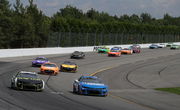

Existing for 76 years, NASCAR has many stories of victory and defeat. Drivers engaged in neck-to-neck racing at 200 mph on close circuits, scripting memorable finishes. However, the sport is also remembered for its wild moments. Started in 1947, the sport’s foundation was Southern moonshiners outrunning cops in cars loaded with whiskey. A whiskey still built by racing legend and former moonshine runner Junior Johnson still stands in NASCAR Hall of Fame’s Heritage Speedway.
It is hard to believe that those lawless days were the origin of present-day NASCAR. Currently, the sport is a sophisticated, high-tech mix of horsepower and marketing, with races run across the country. However, those wild memories may remain immortal in the sport’s history.
ADVERTISEMENT
Article continues below this ad
Chaotic fun in NASCAR’s early days
With a whiskey-laden foundation, the very first decade of the sport witnessed some hilariously wild moments. During the very first Southern 500 race, Herb Thomas qualified 29th in a rented 1950 Plymouth. But since he did not have money, a tow truck took away the car on race day. Interestingly, that was not the end of Thomas’ NASCAR career. In the following year, he made the switch to the Hudson Hornet based on a recommendation from another racer, and won the race!
Then Ralph Webb, a fan who drove his 1950 Buick to the same track, could not drive it back home. An inebriated person stole a Piper Club airplane and drove it straight into Webb’s car at the racetrack. This drinking chaos was not just limited to local pilots, as drivers indulged in the liquid pleasure as well.
NASCAR Hall of Famer Buck Baker was a prolific racer. As part of his racing recipe, the veteran driver packed some special tomato juice whenever he went out to race. According to a report, “Before pool suits and supplemental oxygen, Buck used to keep cool by swigging on a jar of enhanced tomato juice in his car.” He faced an unfortunate consequence as well: “One day, he was involved in a terrible-looking crash in Darlington. The tomato juice jar broke and spilled all over him.” When safety workers reached his car, they believed he had faced a gruesome injury because of the crash! Fortunately, Baker recovered well, going on to win two championships later in consecutive years.
75 YEARS AGO TODAY.
The first NASCAR “strictly stock” — now Cup Series — race was held at Charlotte Speedway on June 19, 1949. pic.twitter.com/6U3KZboOfF
— NASCAR on NBC (@NASCARonNBC) June 19, 2024
What’s your perspective on:
Do you think today's NASCAR has lost the rebellious spirit of its moonshine-running roots?
Have an interesting take?
Similarly, in April 1952 at Columbia Speedway, a drunk fan tried to cross the track under green – EC Ramsey got out of his car and beat the fan. Besides the liquid adventures, drivers have driven under odd circumstances. In 1950, Jimmy Florian won the Dayton, Ohio dirt track – due to high temperatures, he drove the race with no shirt on. Then in 1952 Southern Flock, Bonny Flock won the race wearing shorts. The most startling novelty came in the 1952 sportsman race at Daytona. Tim Flock did not have a roll cage in his car – so he and his brothers built a roll cage out of wood. Flock won the race – officials were stunned by his victory in a self-innovated car. Ultimately, he was disqualified, and the win was given to Jack Smith.
All these incidents originated from NASCAR’s earliest pioneers, who traded liquor.
ADVERTISEMENT
Article continues below this ad
Trending
A true determination to drive fast
Standing in 2024, we remember the instances when drivers were insanely fast. Ross Chastain rode the wall to overtake his opponents to the finish line in 2023 Martinsville in the iconic ‘Hail, Melon’ move. Then Kyle Larson’s indomitable speed was apparent during the Fall Bristol race this year. But none of these incidents can hold a candle to the evergreen origins of NASCAR. While other forms of racing go back to driving cars on track, NASCAR goes back to the Prohibition period in the United States. With alcohol banned across the country, bootleggers needed a way of transporting alcohol without getting caught.
The idea was simple. Moonshiners booted their cars with illegal whiskey and fled from the police. They stripped the car of non-essential parts. The floorboards, passenger seats, and back seats were dumped to make space for cases of alcohol. Bootleggers added power to the engine to make sure they stayed clear of the authorities. Junior Johnson outlined the difference between them and racers. “Moonshiners put more time, energy, thought, and love into their cars than any racer ever will. Lose on the track and you go home. Lose with a load of whiskey and you go to jail.” The punishment for bootleggers at the time meant fines of $5000 or even jail up to 5 years.
ADVERTISEMENT
Article continues below this ad
Johnson was the best-known bootlegger in Wilkes County, North Carolina, a hotbed of the moonshine industry. Being an exceptionally skilled driver and brilliant mechanic, he would modify the engines of his cars to produce more power. He would also add heavy-duty suspension components to safely carry the extra weight of all the liquor. Besides Johnson, many NASCAR legends partook in this illegal trade. Virginia drivers who were bootleggers included Wendell Scott and Curtis Turner. Tim Flock, a two-time NASCAR premier series champion in the 1950s, shuttled hooch back and forth between Alabama and Atlanta before turning to racing.
The origin of NASCAR was chaotic, to say the least. Cherishing these golden memories is what keeps the roots of this racing legacy strong!
ADVERTISEMENT
ADVERTISEMENT
ADVERTISEMENT
ADVERTISEMENT






Do you think today's NASCAR has lost the rebellious spirit of its moonshine-running roots?